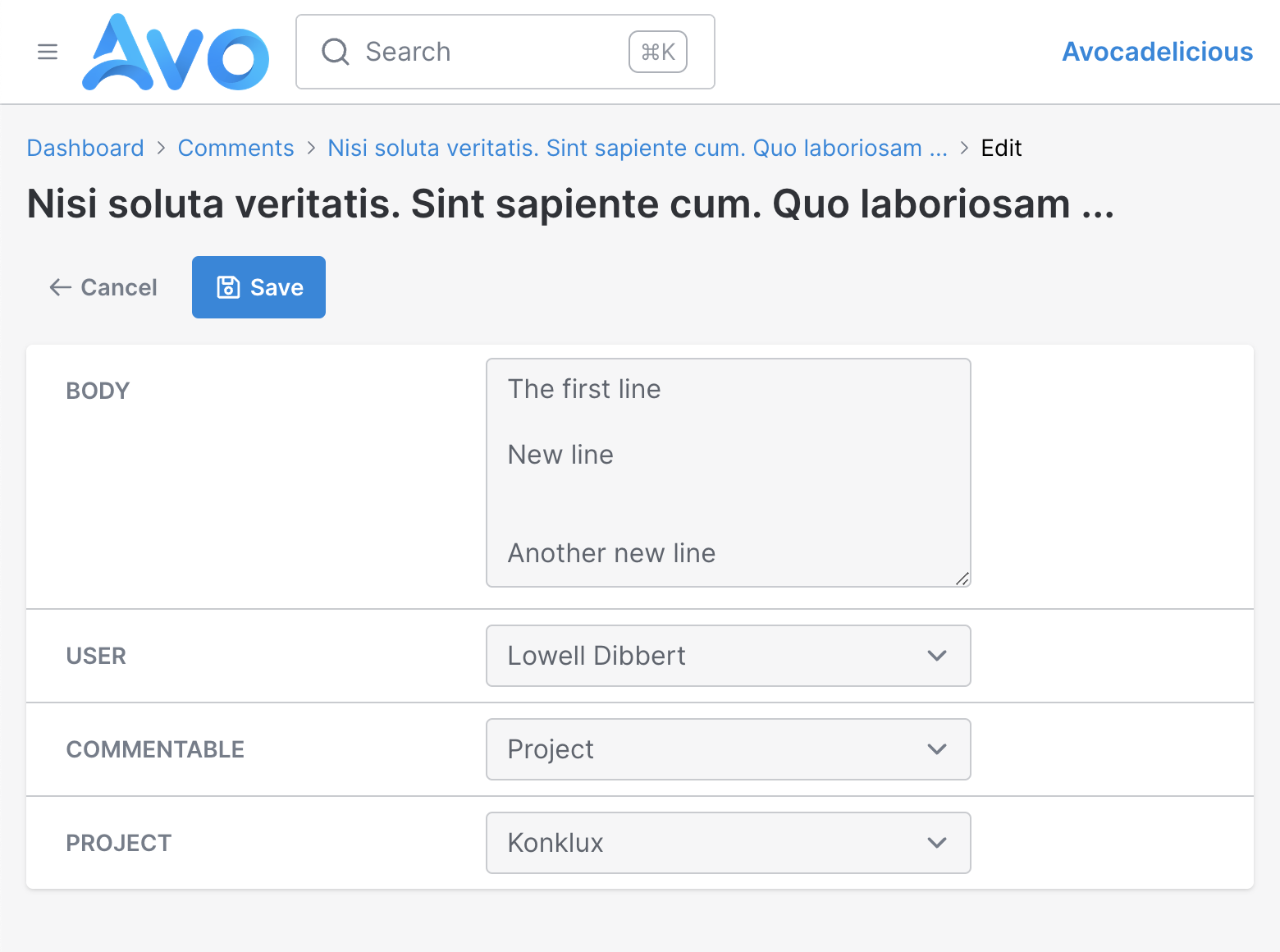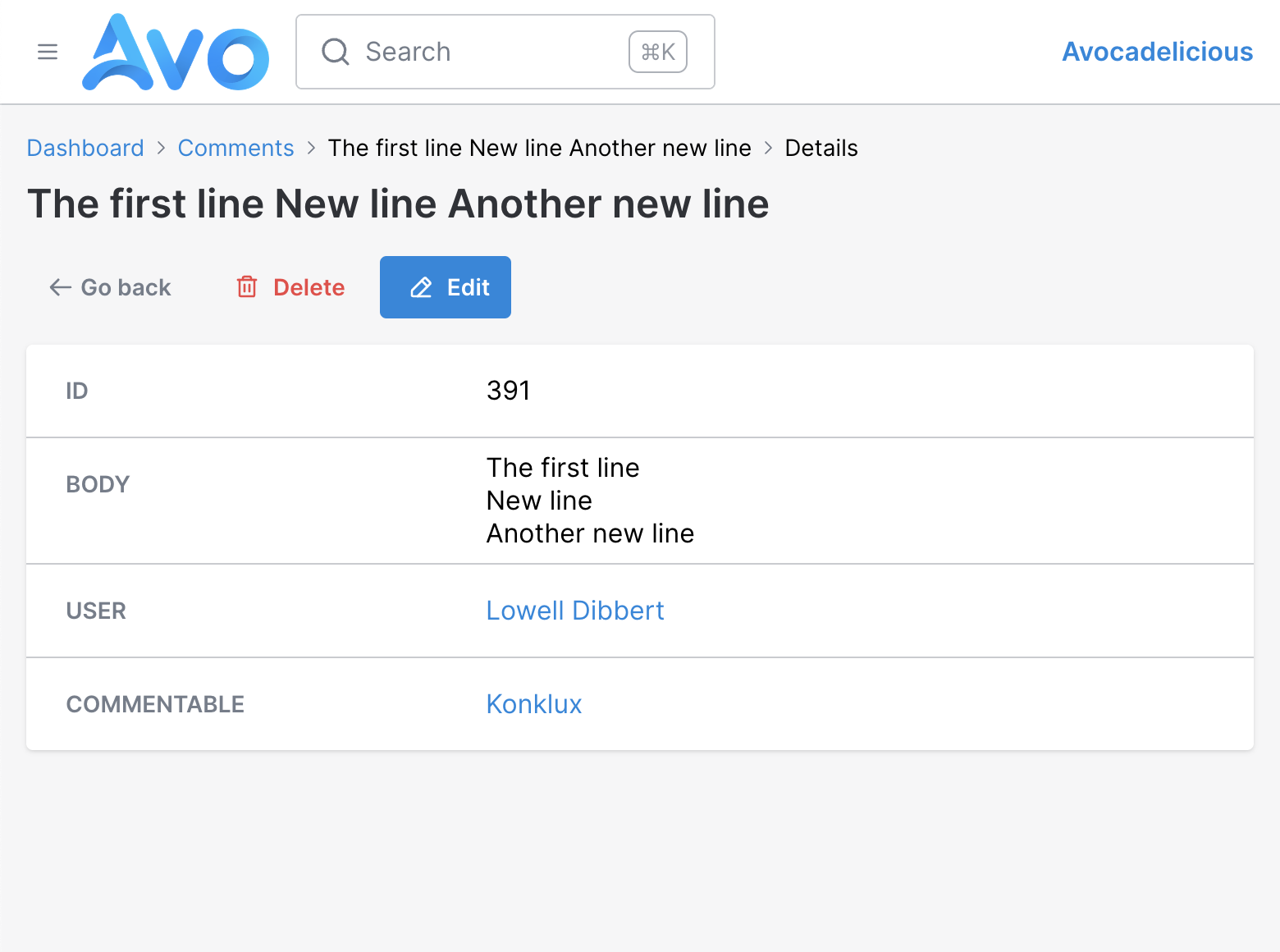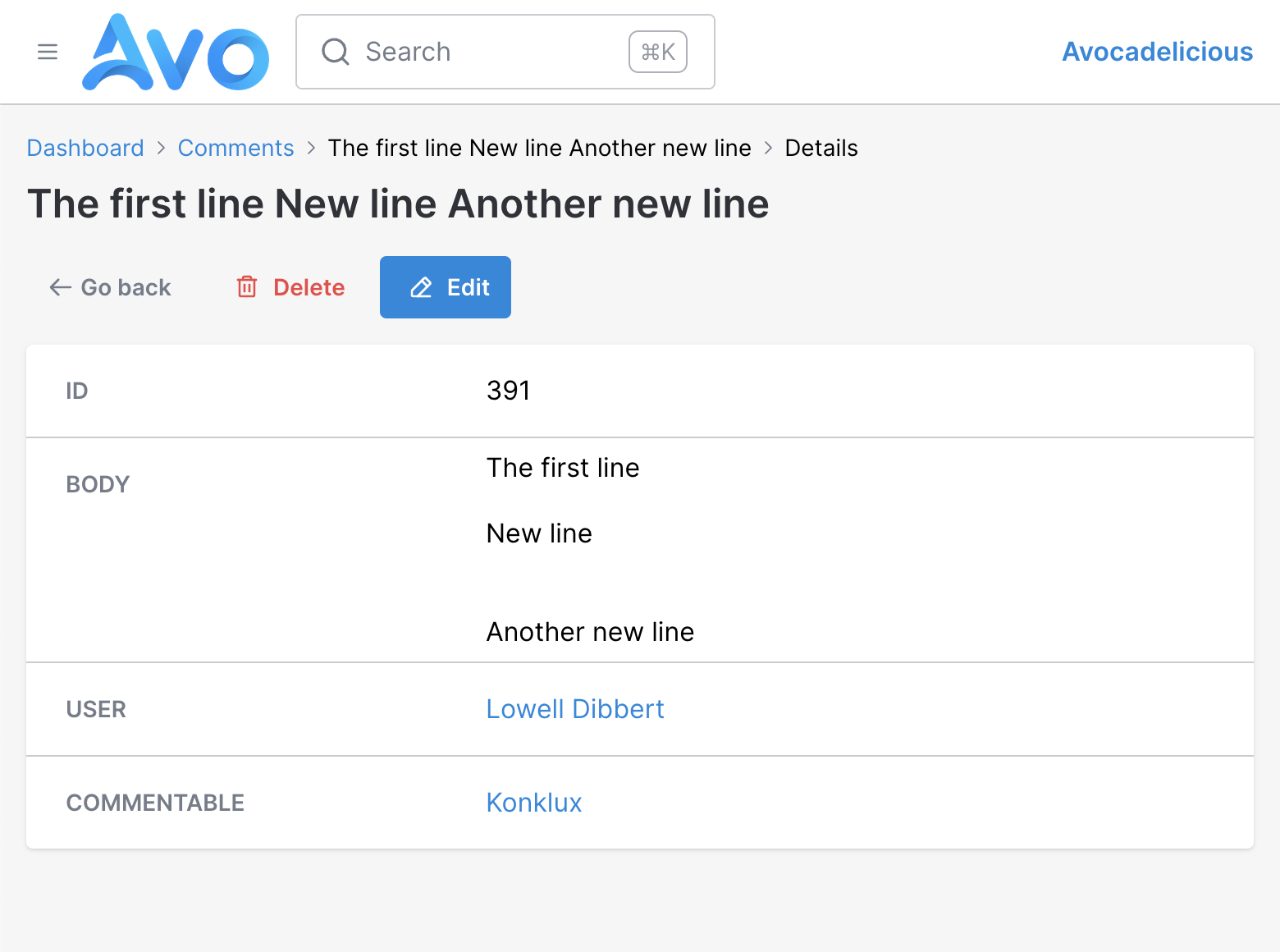# FAQ
- Why don't regular url helpers work as expected?
- Use helpers
- Show/hide buttons throughout the app
- I want to give access to different kind of users to different resources.
- How can I set a homepage for the admin section
- I want to have 2 different resources mapped to the same model with different types
- Try a pre-release version
- The authorization features are not working
- Add custom methods/get custom data
- Get access to the ActionView helper methods
- Render new lines for textarea fields
# Why don't regular url helpers work as expected?
When writing rails code somewhere in Avo domain you might want to use your regular url helpers like below:
field :partner_home, as: :text, as_html: true do |model, *args| link_to 'Partner', partner_home_url(model) endCopied!
This will not work because Avo will execute that code inside itself, a Rails engine. So per the Rails documentation (opens new window) you have to preprend the helper with main_app for it to work. Rails needs to know which engine it should find a route for. So the above query becomes this 👇
field :partner_home, as: :text, as_html: true do |model, *args| link_to 'Partner', main_app.partner_home_url(model) endCopied!
# Use helpers
You probably have some helpers already set up in your app and would like to have them available in Avo too.
module ApplicationHelper def tag_url(model) "/#{model.something}" end endCopied!
You need to include it in the Resource controller of choice and then refernce it in the field through the view_context object.
class Avo::CustomersController < Avo::ResourcesController include ApplicationHelper end class CustomerResource < Avo::BaseResource field :tag, as: :text, format_using: ->(value) do link_to value, view_context.controller.tag_url(model), target: :_blank end endCopied!
# Show/hide buttons throughout the app
You might want to hide some buttons and not show them to your users. That's pretty handy using the Authorization feature. You control the display of those buttons using the policy methods.
- Show button ->
show?method - Edit button ->
edit?method - Delete button ->
destroy?method - Upload attachments button ->
upload_attachments?method - Download attachments button ->
download_attachments?method - Delete attachments button ->
delete_attachments?method - Attach button ->
attach_#{RESOURCE_PLURL_NAME}?(eg:attach_posts?) method - Detach button ->
detach_#{RESOURCE_PLURL_NAME}?(eg:detach_posts?) method
# I want to give access to different kind of users to different resources.
You can do that using Pundit scopes and the Authorization feature. You create a policy for that resource and set the condition on the index? method. More on that on the authorization page and Pundit's docs (opens new window).
Authorization is a Pro feature for Avo. Please let us know if you need a trial key to test it out.
# How can I set a homepage for the admin section
You can do that using the home_path configuration. You just set config.home_path = "/avo/resources/posts" (or whatever path you'd like) in the Avo initializer and you're all set up. The user will be redirected to that path when navigating to /avo.
# config/initializers/avo.rb Avo.configure do |config| config.root_path = '/avo' config.license = 'pro' config.license_key = ENV['AVO_LICENSE_KEY'] config.id_links_to_resource = true config.home_path = '/avo/resources/posts' config.set_context do { foo: 'bar', user: current_user, params: request.params, } end endCopied!
# I want to have 2 different resources mapped to the same model with different types
This depends on your setup:
- If you have Rails STI (opens new window), then it will work. Avo knows how to handle STI models. So you'll have two models and an Avo resource for each one. That will render two resources in your admin panel's sidebar.
- You don't have Rails STI but something custom. Then the response is it depends. Because something custom is... custom, we offer a few mechanisms to get over that.
If you have one model User, then you'll have one Avo resource UserResource.
Then you can customize different things based your requirements. Like if for instance you want to show only some types of users on the Index view, you can use custom query scopes (opens new window) to hide specific types (if that's what you want to do).
Same if you want to show/hide fields (opens new window) based on the type of resource or type of user.
All in all we're confident you'll have the necessary instruments you need to build your admin.
# STI example
For STI you can check out the models and resources in the demo app (opens new window).
- person.rb (opens new window)
- spouse.rb (opens new window)
- person_resource.rb (opens new window)
- spouse_resource.rb (opens new window)
One thing you should do is for the derived model (Spouse in this case) add the model_class to the Avo resource (opens new window).
# Try a pre-release version
From time to time we push pre-release versions of the gem for you to try out before pushing to the main branch. To test them out you need to specify the exact version in your Gemfile.
Let's say you want to try out 1.19.1.pre.1. You need to specify it like below 👇
# Gemfile # ... other gems gem 'avo', '1.19.1.pre.1'Copied!
# The authorization features are not working
If you're having trouble with the authorization feature, make sure you have the following enabled:
- you are on a Pro license
- you have set the
current_user_method - you have reset the rails server after the above settings
- you have the pundit policy on the appropriate model
# Add custom methods/get custom data
You might want to be able to send custom data to some of the blocks you use (default block, computed fields, field formatters, etc.). You can use the context block. The block is evaluated in the ApplicationController so it has access to the params and other common controller methods. More on that here.
# Get access to the ActionView helper methods
For convenience sake, we capture the view_context for you and set it to the Avo::App.view_context global object. You can use all the ActionView methods you'd regularly use in your helpers throughout your Avo configuration.
On the Resource and Field classes, it's already delegated for you, so you can just use view_context.
class CommentResource < Avo::BaseResource field :id, as: :id field :body, as: :textarea, format_using: -> (value) do view_context.content_tag(:div, style: 'white-space: pre-line') { value } end field :computed_field, as: :text do |model| view_context.link_to("Login", main_app.new_user_session_path) end endCopied!
# Render new lines for textarea fields
From version 2.8
When adding content using the textarea field, you might see that the newlines are not displayed on the Show view.
class CommentResource < Avo::BaseResource field :body, as: :textarea endCopied!


You can change the way you display the information there by using the format_using option.
# Use simple_format
class CommentResource < Avo::BaseResource field :body, as: :textarea, format_using: -> (value) do simple_format value end endCopied!

# Use the white-space: pre-line style rule
class CommentResource < Avo::BaseResource field :body, as: :textarea, format_using: -> (value) do content_tag(:div, style: 'white-space: pre-line') { value } end endCopied!

# Use the whitespace-pre-line class
class CommentResource < Avo::BaseResource field :body, as: :textarea, format_using: -> (value) do content_tag(:div, class: 'whitespace-pre-line') { value } end endCopied!

